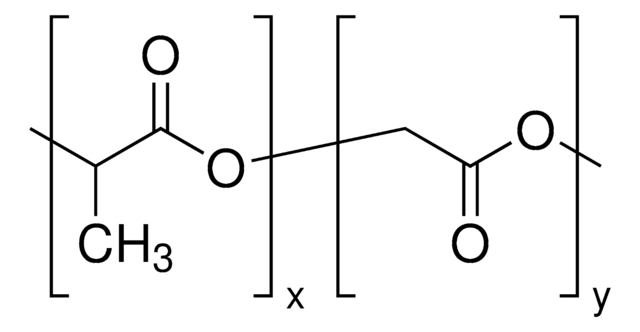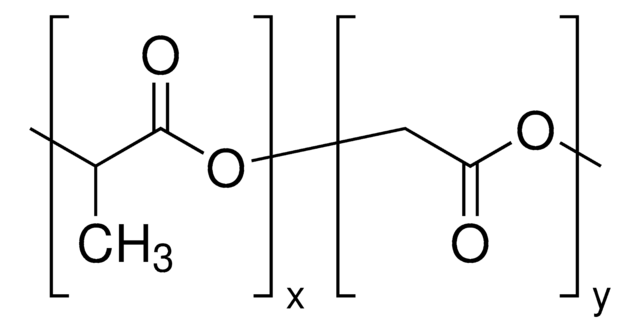739960
Resomer® RG 505, Poly(D,L-lactide-co-glycolide)
ester terminated, Mw 54,000-69,000
Synonim(y):
PLGA
About This Item
Polecane produkty
Postać
amorphous
proporcje
lactide:glycolide 50:50
masa cząsteczkowa
Mw 54,000-69,000
ramy czasowe degradacji
<3 months
lepkość
0.61-0.74 dL/g, 0.1 % (w/v) in chloroform(25 °C, Ubbelohde) (size 0c glass capillary viscometer)
temp. przejścia
Tg 48-52 °C
temp. przechowywania
2-8°C
InChI
1S/C6H8O4.C4H4O4/c1-3-5(7)10-4(2)6(8)9-3;5-3-1-7-4(6)2-8-3/h3-4H,1-2H3;1-2H2
Klucz InChI
LCSKNASZPVZHEG-UHFFFAOYSA-N
Powiązane kategorie
Opis ogólny
Zastosowanie
Informacje prawne
Kod klasy składowania
11 - Combustible Solids
Klasa zagrożenia wodnego (WGK)
WGK 3
Temperatura zapłonu (°F)
Not applicable
Temperatura zapłonu (°C)
Not applicable
Certyfikaty analizy (CoA)
Poszukaj Certyfikaty analizy (CoA), wpisując numer partii/serii produktów. Numery serii i partii można znaleźć na etykiecie produktu po słowach „seria” lub „partia”.
Masz już ten produkt?
Dokumenty związane z niedawno zakupionymi produktami zostały zamieszczone w Bibliotece dokumentów.
Klienci oglądali również te produkty
Produkty
Interest in utilizing biodegradable polymers for biomedical applications has grown since the 1960s.
Syntetyczne poliestry alifatyczne dominują wśród biomateriałów resorbowalnych w zastosowaniach klinicznych.
Synthetic aliphatic polyesters dominate resorbable biomaterials in clinical use.
AliAliphatic polyesters, including polylactide and polyglycolide, are biodegradable polymers widely used in medical applications.
Nasz zespół naukowców ma doświadczenie we wszystkich obszarach badań, w tym w naukach przyrodniczych, materiałoznawstwie, syntezie chemicznej, chromatografii, analityce i wielu innych dziedzinach.
Skontaktuj się z zespołem ds. pomocy technicznej








